Last Updated on: February 4, 2025
Ohio has eight owl species though there are rare sightings of other owls like the great gray owl and the boreal owl.
Of these eight owls, the one I’d love to see first is the snowy owl because of its ghostly, white plumage. It’s so stunning! I’d also love to hear the call of a barred owl.
But…
It’s not about me; it’s about us telling you where to see owls in Ohio, which ones you’ll see more, and when. Let’s do that!
Ohio Owls: Habitats, Physical Features & Everything Else
Owls aren’t popular with the general public because they’re mysterious. But for you, a bird enthusiast, discovering the owls of Ohio is an adventure like any other birding tour, and we want to give you facts only. Read on!
1. Eastern-screech Owl
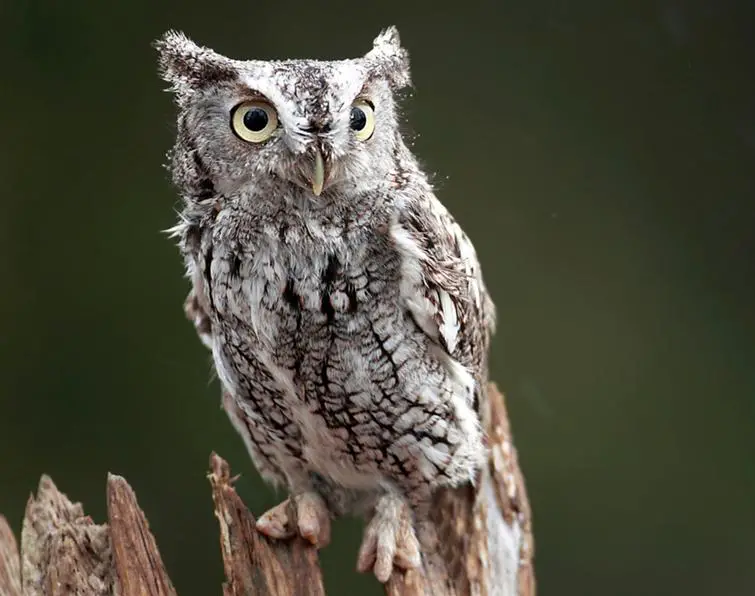
When it comes to spooky birds, this one scoops the prize. It’s short, stocky, with pointed ear tufts, and doesn’t have a neck. You have to see it.
The gray morph has grey feathers and yellow eyes, while the red morph has a reddish-brown body with darker streaks.
Eastern-screech owl length is between 6.3 and 9.8 inches, which means they’re small owls. These tiny owls in Ohio inhabit almost every woodland in this state, as long as larger Ohio owls aren’t there. Also, you have to look for eastern-screech owls a bit longer because they camouflage in tree crannies.
An eastern-screech owl has many songs and calls, but the one you’ll hear the most is a pitched trill.
Eastern-screech owls eat small mammals, insects, birds, and amphibians. Some days, they pounce on mice and rats, while other days, they prefer finches and thrushes.
Like most owl species, eastern-screech owls take over nests of other animals like squirrels or woodpeckers.
2. Barred Owl
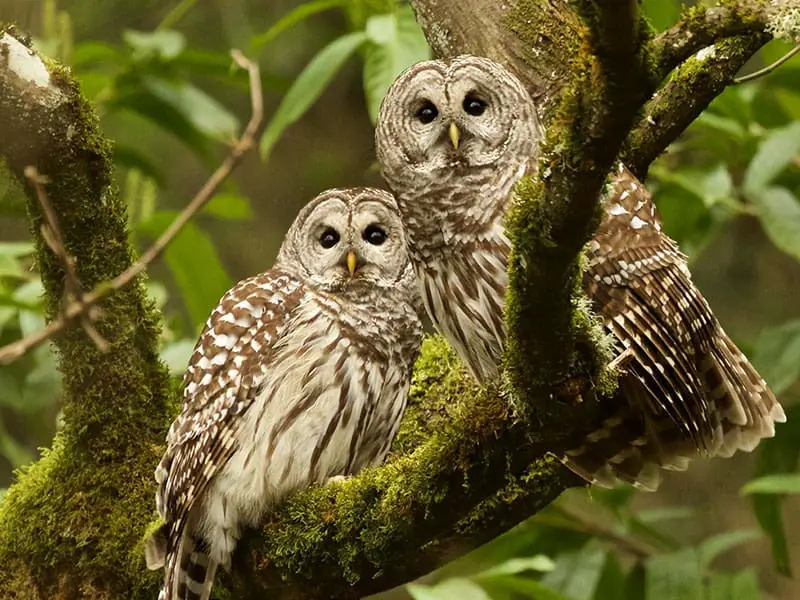
It got its name from the bar-patterned feathers on its body and tail. Another name for a barred owl is a hoot owl, one it shares with the great horned owl. It’s a nocturnal species found in mature forests. However, you might see it feeding during the day.
There are no barred owls in most western states like Colorado, New Mexico, Montana, and Idaho, as it inhabits eastern states, including Ohio.
A barred owl’s diet isn’t limited to small mammals since it also eats reptiles and amphibians. It can perch on the water to catch fish or wade through shallow water to run after prey. It builds a nest about 40 feet from the ground, but if it gets a platform nest, whether belonging to a hawk or squirrel, or a nest box in a backyard, it doesn’t bother building its own.
You’ll be thrilled when you hear the unique call of barred owls that sounds something like, who cooks for you?
Barred owl length is between 16.9 and 19.7 inches long; therefore, it’s larger than a northern hawk owl. Unlike other owls in Ohio with yellow eyes, barred owls have dark eyes and yellowish bills. Their backs are brown and mottled white, while their buffy undersides flaunt dark streaks.
3. Long-eared Owl
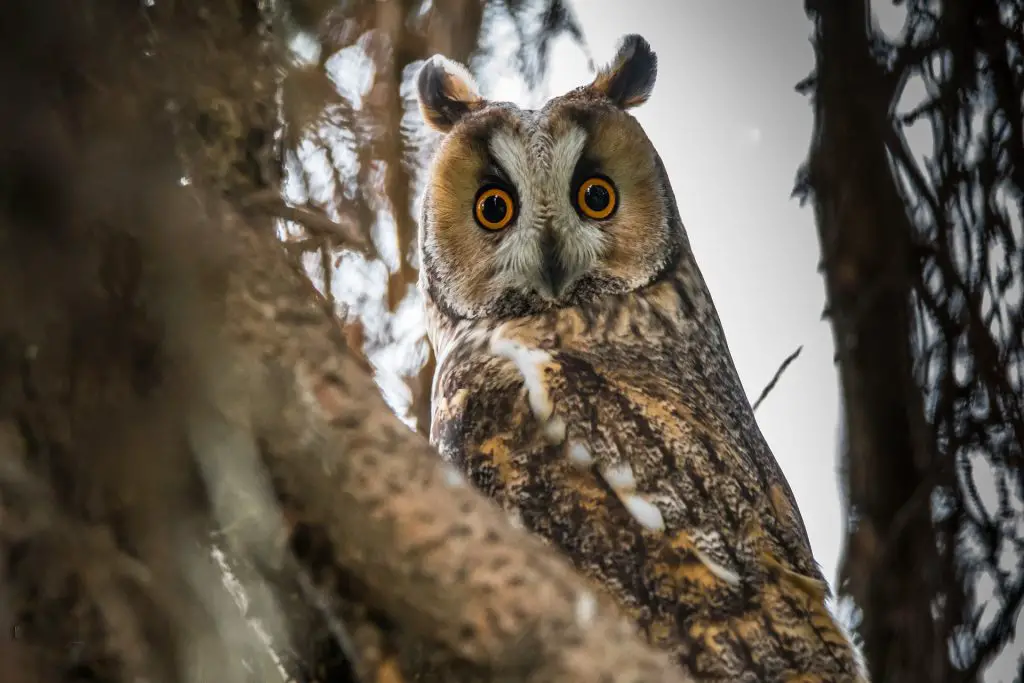
It’s one of the few birds with numerous names, as you can also call it the northern long-eared owl, the cat-owl, or the lesser horned owl.
As one of these names suggests, long-eared owls have cat-like faces. They’re a very secretive species that camouflages so well you might take the longest time to find them unless they come out to hunt small mammals like rats and mice.
So, where should you look for this Ohio owl?
You’ll see the long eared-owl hunting small mammals on open grounds or looking for small birds below the canopy in forests with scattered vegetation.
Long eared-owl length measures 13.8 to 15.8 inches, so it’s not as large as the great horned owl. You’ll tell it apart from other avians by its striking long ear tufts, yellow eyes, and orange facial disc.
Long-eared owls roost in dense forests during the day and forage in grasslands and open country.
Ohio is in the wintering range of these medium-sized species, so if you want to see long-eared owls every day, you have to go to the northeastern side of the state of Ohio.
One place that’ll never disappoint is the Killdeer Plains Wildlife Area.
4. Great-horned Owl
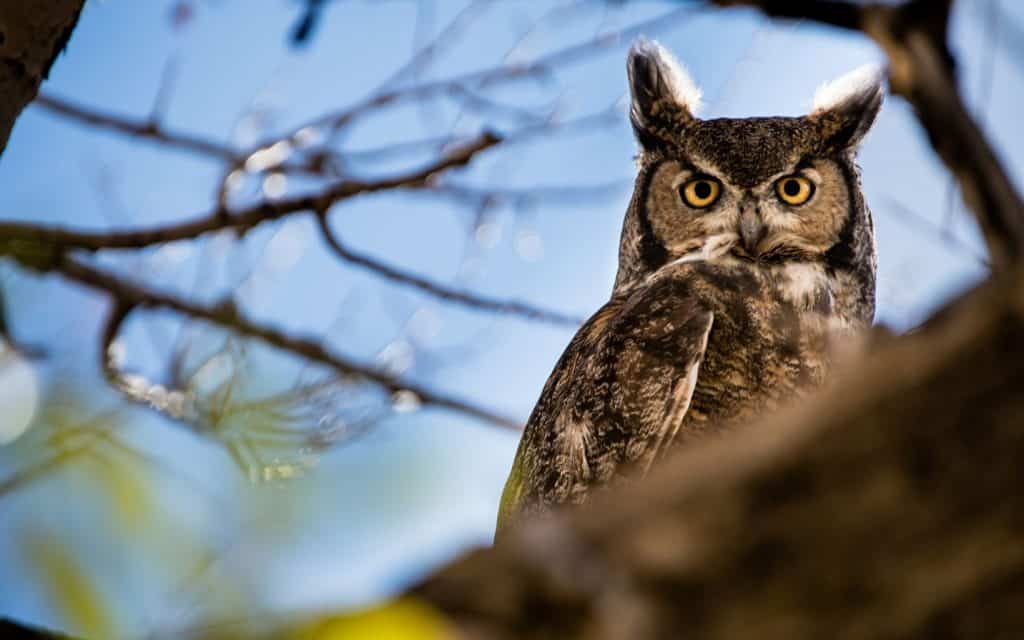
The great-horned owl, or tiger owl, is famous because you can see it throughout North America and in parts of Central and South America. The great-horned owl’s length is between 18.1 and 24.8 inches, so it’s one of the largest owls.
Its most prominent features are yellow eyes and large ear tufts. This Ohio owl has gray-brown plumage, a reddish-brown face, and a white patch on the throat. However, there are regional differences, with some great horned owls displaying sooty to pale feathers.
Another identification feature is the call, as great horned owls make a series of up to five hoots. If you don’t see them in your neighborhood, look for them in woodlands between open fields.
So what do these birds eat? Great horned owls eat small rodents, birds, fish, reptiles, and insects.
Lastly, great-horned owls don’t have a specific nest size because it depends on who the former occupant was, from the red-tailed hawk to the heron.
5. Northern Saw-whet Owl
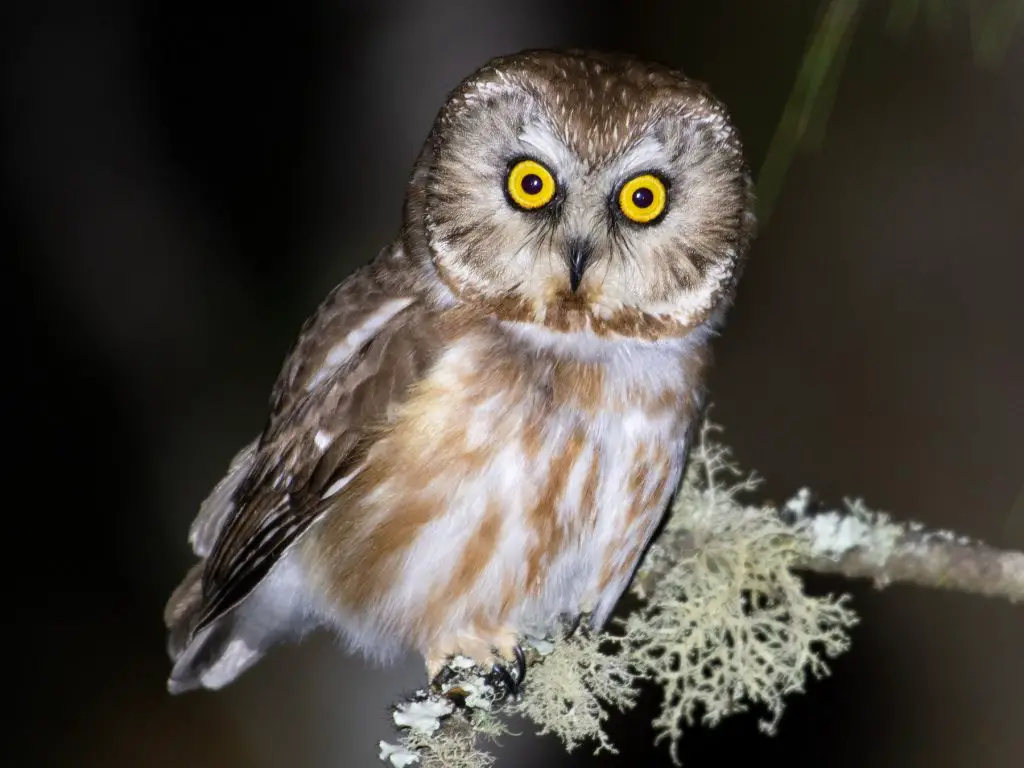
If you come across a tiny owl, it’s most likely a northern saw-whet owl. Its name is probably because its call sounds like someone sharpening a saw on a whetting stone.
Striking features include yellow eyes, a small head, and white streaks on the head with a V patch between the eyes. The rest of the body has mottled brown feathers. Juvenile birds have different plumage from the adults as they have a cinnamon belly and a brown back.
Northern saw-whet owl length is between 7.1 and 8.3 inches; consequently, we rank these birds as the smallest owls in Ohio.
Resident birds are in the northern area as Ohio is in the wintering range. These nocturnal birds spend the day resting in a dense forest close to a river and only come out at night. There’s a small population of northern saw-whet owls because dense forests near a river are rare.
Instead of building its own nest, a Northern saw-whet owl takes up a nest box or holes left by woodpeckers.
The females breed with several mates. When the first chicks grow feathers, the female incubates another clutch with a different male.
6. Barn Owl

Unlike most owls, the barn owl is non-migratory, meaning you can see it any time of the year. It’s a nocturnal species that prefers barns to forests, and that’s why it’s called a barn owl. Some birders also call it the monkey-faced owl or the ghost owl. It’s so unfortunate that this is an endangered species, so you’re lucky if you see any in Ohio.
But when you do, you’ll see barn owls in a barn helping the farm owner get rid of small rodents by eating all the rats, voles, and mice. They also visit bird feeders, searching for starlings and blackbirds.
Barn owl length is between 12.6 and 15.8 inches long; hence, these are medium-sized owls like short-eared owls.
Barn owls are easy to ID because this owl species has a white face in the shape of a heart, gray and cinnamon back, white underbelly, and sometimes, spots on the chest.
A barn owl has a screechy call like a red-tailed hawk. What is even more interesting about barn owls is how a male attracts a female by flapping its wings severally as it flies. The North American barn owl is the largest owl among subspecies.
7. Short-eared Owl
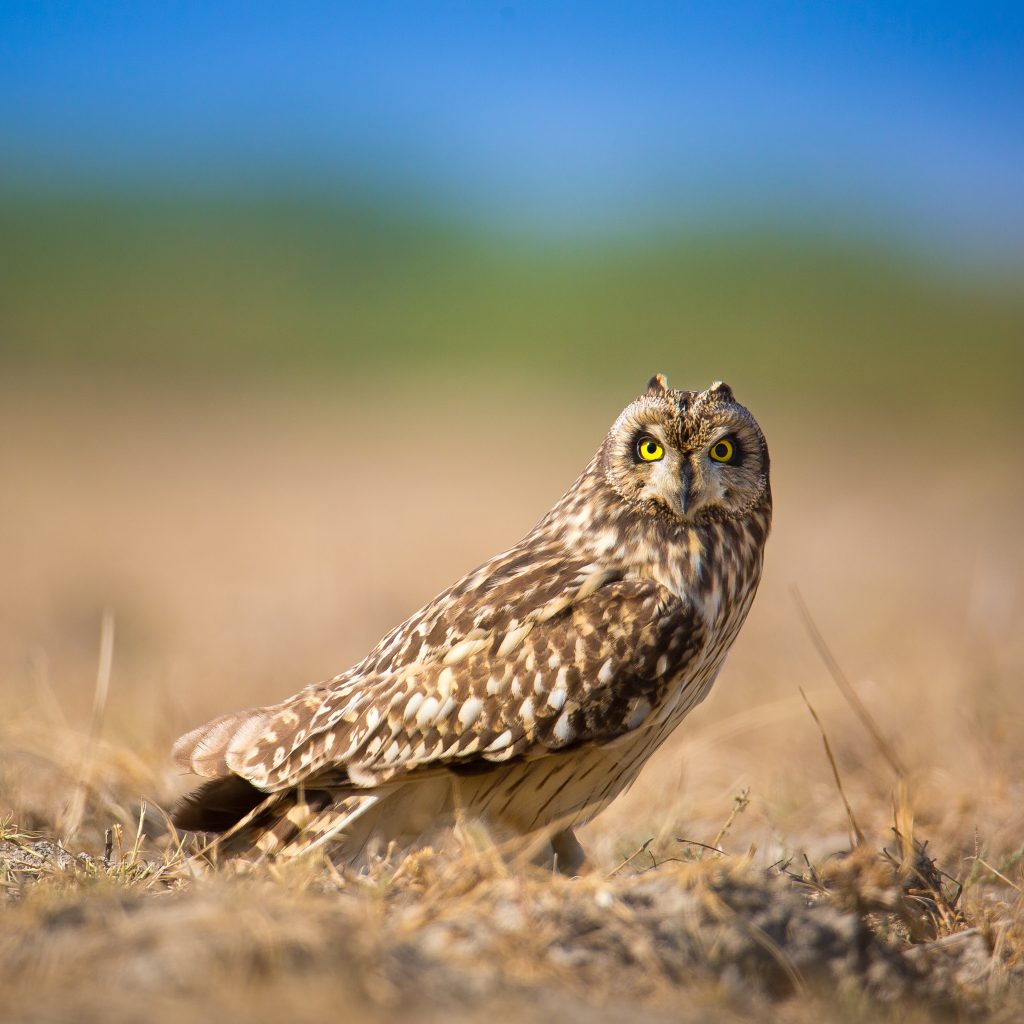
The short-eared owl’s resident population inhabits central North America, the wintering grounds are South, and the breeding range is north.
Therefore, you’ll only see it throughout the year in northern Ohio while the rest of the state houses wintering birds.
You can differentiate a short-eared owl from a great horned owl by its plumage, as it has a whitish face, barred wingtips, and ear tufts that’ll barely notice unless you’re looking at it from a close distance.
Short-eared owl length is between 13.4 and 16.9 inches long. Hence, it’s one of the smaller owls that’ll have you looking far and wide to find it. Fortunately, short-eared owls hunt during the day and fly low to the ground for you to see them.
Short-eared owls watch their prey from a post, then flap their rounded wings through the grassland or open area.
What does this owl eat? Like other owls, you’ll see it hunting mice, mice, and songbirds.
But, unlike others, the short-eared owl builds its nests. Sometimes, it nests on top of the previous structure.
8. Snowy Owl
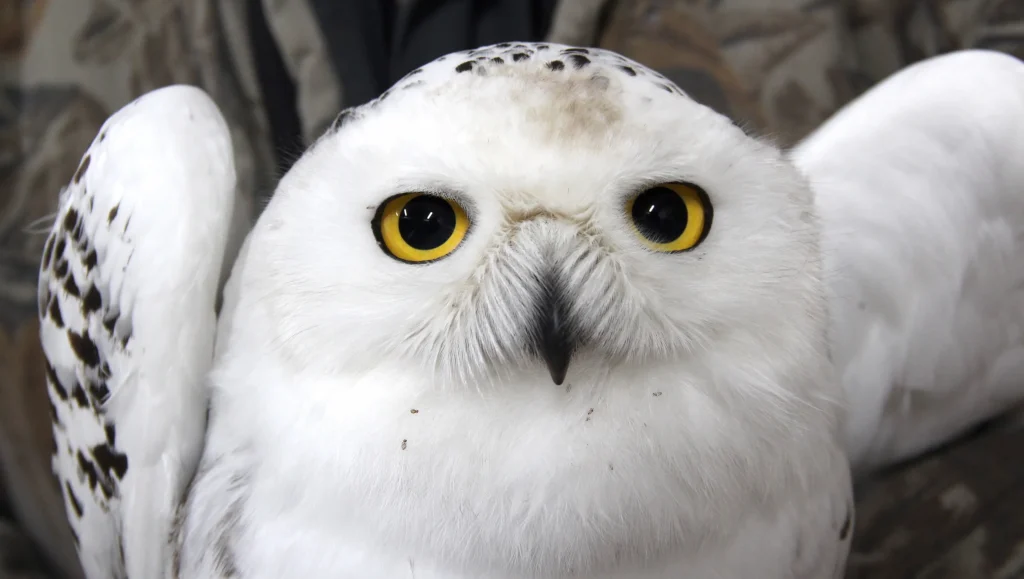
We’ve only listed it here because you’ll see the snowy owl in Ohio, albeit on the northern edge only because Ohio is in the southern boundary of the wintering range. You have to see this stunning creature because its white body is something to capture on your camera.
So, where do you find snowy owls? Look for them near or on the ground in open areas, shorelines, or agricultural fields. You might also see them perched on fence posts. Also, snowy owls stay close to the ground when they fly.
A snowy owl has piercing yellowish eyes, and you might come across some birds with brown spots though most of them have white plumage only. Female and immature birds have some darker barring except on the face.
Snowy owl length is between 20.5 and 27.9. Therefore, these are the largest owls in OH.
The male bird has a loud hoo-hoo hoot that travels up to seven miles in the tundra.
Watch This!
Frequently Asked Questions
Which species of owls live in Ohio?
There are eight owl types. Some are resident birds seen year-round, while others, such as the northern saw-whet owls, are migratory. One of the best places to see them is along Lake Erie.
How do you attract Ohio owls?
Small owls are easy to attract with nest boxes. Other ideas you can try in your backyard are installing bird baths, mowing your lawn less to attract small rodents, and letting your trees grow large for owls to perch.
What is the most common owl in Ohio?
The most common owls are the great horned owl and the eastern-screech owl, though the latter is the one you’ll see more in forests and backyards.
Conclusion
You’ll agree that owls are fascinating birds, from how they hoot to their nocturnal habits. Fortunately, Ohio has many species, meaning if you’re only birding to see owls, you have enough work on your hands. For instance, you can start with the ones with yellowish eyes or dark morph.
You can even make the experience more exciting by recording Ohio owl sounds instead of only taking pictures of sightings. That’ll have you spending more time listening to avians, such as snowy owls, in dense forests. Which owl would you like to see first?

